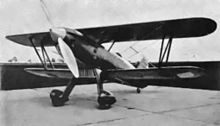Avia B-534
| Avia B-534 | |
|---|---|

|
|
| Type: | Fighter plane |
| Design country: | |
| Manufacturer: | |
| First flight: |
May 25, 1933 |
| Commissioning: |
1935 |
| Production time: |
1935-1939 |
| Number of pieces: |
566 |
The Avia B-534 was a Czechoslovakian single-engine biplane - fighter aircraft , which in the 1930s of Avia was developed and also in the Second World War was used.
history
This fighter, typical of the 1930s, emerged from the less successful predecessor Avia B-34 by installing a new engine. The designer František Novotný had previously carried out calculations for three different engine constellations, but it was not until he used a Hispano-Suiza-12-Ybrs drive that the actual B-534 was created, which was initially designated B-34.2 (based on the original model) ( from September 1933: B-534.1). The first flight of the first prototype, for the construction of which the airframe of the Avia B-234 was used, took place on May 25, 1933 with Václav Kočí at the wheel. The second prototype B-534.2 already had a closed cockpit, enlarged rudders and a disguised landing gear. It completed its first flight on September 25, 1933. With this configuration, the aircraft set a Czechoslovak speed record on April 14, 1934 with 365.744 km / h over a distance of three kilometers. The ČSR air force then ordered the first series copies, although both prototypes crashed shortly afterwards in crash landings. A comparison flight between the Polish PZL P.8 and P.24 and the B-534.2 , which was allegedly carried out in Yugoslavia in July 1934 , never took place, because Kočí only presented the machine there statically.
On July 17, 1934, the Ministry of Defense de facto agreed to series production and ordered a first series of 34 machines under the number č.j.1031-V / 3. However, since the Ministry of Defense wanted the B-534 to be built by Letov and Aero , which Avia refused, they did not commit to a total delivery of 147 machines until early 1935. In autumn 1935 the first B-534, equipped with an Avia-Ydrs engine (license Hispano-Suiza ), were handed over to the air forces. The first unit that was fully equipped with the new fighter was the 4th Air Regiment stationed in Hradec Králové, which received a total of 52 fully equipped B-534s between October 8, 1935 and January 14, 1936.
From July 23 to August 1, 1937, the international flight meeting took place in Zurich , at which the B-534 took second place behind the Bf 109, which also took part in categories A (international alpine round flight) and C (tripartite flight).
The B-534 was manoeuvrable, reliable, easy to fly and, thanks to its riveted and screwed tubular steel construction, also suitable for use on field airfields. A total of 566 copies, according to other sources 584, were built in four different series versions.
At the end of the 1960s, a true-to-scale replica of the 4th series was realized in the Trenčin repair plant using fuselage and wing fragments and an engine that was still in existence. Its first flight took place on June 5, 1975. It can be viewed in the Czech Aircraft Museum Prague-Kbely .
commitment
The B-534 was declared the standard fighter aircraft when it was introduced into the air force of the Czechoslovak Republic and was also used for aerial photography and, thanks to its underwing bomb locks for up to 60 kilograms of bomb load, also as a ground attack aircraft. When Czechoslovakia was occupied by German troops in March 1939, 21 squadrons were equipped with the B-534, the majority of which were taken over by the Slovak government and used for ground attacks during the Little War . There were also aerial battles with Hungarian CR-32 fighters . During the attack on the Soviet Union in 1941, the Slovak aircraft were used in three squadrons on the Ukrainian front, but withdrawn from the first line in mid-1942 and used as training aircraft after appropriate conversion.
78 specimens from ČSR holdings were delivered to Bulgaria after the German occupation under the name Dogan .
In the German Air Force , the B-534 were used as advanced trainers, anti-aircraft targets and as tow planes for the cargo gliders DFS 230 , for example in the 2nd group of Airborne Squadron 1 . In 1939/40 a squadron served in Friedrichshafen with JG 71. For deck landing attempts on the aircraft carrier Graf Zeppelin , three machines were equipped with catch hooks.
On its flight over Bulgaria, a Consolidated B-24 bomber formation was attacked during Operation Tidal Wave on August 1, 1943 by a squadron with ten Messerschmitt Bf 109s and six Avia B-534s, which had ascended from the airports of Vrashdebna near Sofia and Karlovo . Due to the weak armament of the Avia B-534 (four 7.92 mm machine guns), the Americans suffered only a few total losses; however, many bullet holes and injuries were the result.
When the Slovak popular uprising broke out in the late summer of 1944 , three aircraft were deployed from Tri Duby Airport against the German troops. About ten B-534s survived the war and are said to have been used to tow gliders. However, due to a lack of spare parts, they were scrapped after a short time.
technical description
The model consisted of a rectangular, tubular steel fuselage in composite construction; the front part consisted of removable electron metal plates, the rear part was covered with fabric. In the fuselage there were two fuel tanks, each with a capacity of 135 liters, and another for 50 liters was installed in the middle section of the upper wing.
The double-spar tubular steel frame wings of different span were also covered with fabric and had ailerons above and below. The upper and lower wings were connected to each other with N struts. The normal tail was cross braced, it also consisted of a tubular steel frame with fabric covering. The three-legged chassis had a tail spur, the main wheels could be replaced by runners in winter.
Versions
- B-34 : Forerunner of the B.534. The first flight took place in 1932. A small pilot series of twelve pieces was built.
- B-134 : An improved B-34 with double radial engine Walter Mistral 14kbs, which remained only a project.
- B-234 : Prototype with Avia R-29 radial engine. The tests were discontinued because the engine was not working properly. The model later received the Hispano Suiza 12 Ybrs and thus became the B-534 prototype.
- B-334 / B-434 : Also unrealized projects with Armstrong-Siddeley, Jaguar Major or Hispano-Suiza Xbrs engines.
-
B-534
- 1. Series : First series model that was largely identical to the second prototype. However, the cockpit was open and the propeller was made of wood instead of metal. Two 7.7 mm machine guns were installed in the fuselage and two more in the wings. 100 pieces were produced (series B-534.2-101).
- 2nd series : Second series in which all four machine guns were relocated to the sides of the fuselage, which resulted in corresponding enlargements of the fairings. The type was also equipped with under wing stations for carrying light bombs. 46 machines were produced (series 102–147). The six machines allegedly delivered to Greece were only two B-534s of the 2nd series, privately bought by the businessman G. Koutarellis, which were handed over to the Greek air forces on August 18, 1936 with a ceremonial ceremony. The other four “Avias” were BH-33s that came from Yugoslavia.
- 3rd series : Version with covered main landing gear wheels and the carburetor inlet moved to the front under the bow (series 148–173). 25 copies were delivered to the ČSR Air Force. The 14 machines delivered to Yugoslavia are a fiction based on twelve Avia HS-12Ycrs engines actually delivered for the Ikarus IK-2. The B-534 was not exported to Yugoslavia.
- 4th series : Largest series lot (series 174–445) with rear fuselage rising to the rear, closed cockpit and metal propeller Letov Hd-43. 271 aircraft were ordered, which could not be fully delivered until the German occupation. The remaining 21 pieces, however, were completed under German supervision.
- Bn-534 : From 1938 onwards, some B-534 of the fourth series (from B-534.194) were delivered as night fighters. They were equipped with launchers for flares and night flight equipment. Some older production aircraft have been converted in the same way.
- Bk-534 : Performance -enhanced variant with a 20 mm Mk Oerlikon FFS-20 above the motor. An Avia 12 Ycrs engine (license Hispano-Suiza) with 625 kW served as the drive . 55 pieces were ordered and by autumn 1938 35 pieces had been delivered. Some only had a machine gun instead of a cannon. Another 66 copies were made under German supervision.
- B-634 : A version made from 1935 onwards, aerodynamically refined by smoothing out unevenness on the outer skin, but which only produced a slight improvement in performance. Series production was therefore not carried out. The first flight took place on July 9, 1936. A prototype was created that originally had an open cockpit and was later given a closed one. It later served to test the 20-mm Oerlikon FFS-20 cannon .
Technical specifications
| Parameters | Avia B-534 (4th series) | Avia B-634 |
|---|---|---|
| Conception | Single-engine fighter | |
| Manufacturer | Avia Akciová Společnost Pro Průmysl Letecký | |
| constructor | František Novotný | |
| crew | 1 | |
| Wingspan | 9.40 m | |
| length | 8.20 m | 8.35 m |
| height | 3.10 m | k. A. |
| Wing area | 23.56 m² | |
| Wing loading | 78.0 kg / m² | |
| Empty mass | 1460 kg (Bk-534: 1631 kg) |
1595 kg |
| Takeoff mass | 1980 kg (Bk-534: 2222 kg) |
1910 kg |
| drive | Liquid-cooled, twelve-cylinder - V engine | |
| Number / type | an Avia 12 Ydrs (license Hispano Suiza) | an Avia 12 Ycrs (license Hispano Suiza) |
| power | 634 kW (850 PS) | |
| Top speed | 394 km / h at 4400 m altitude (Bk-534: 375 km / h) |
415 km / h |
| Marching speed | 345 km / h | 380 km / h |
| Initial rate of climb | 15 m / s | 16 m / s |
| Service ceiling | 10,600 m (Bk-534: 9500 m) |
9500 m |
| Range | 580 km | maximum 500 km |
| Armament | four rigid 7.7 mm MG model 30 , two each on the left and right sides of the fuselage |
two 7.7 mm model 30 machine guns above the engine of a 20 mm Hispano 402 cannon |
| Drop ammunition | six 20 kg bombs at underwing outstations |
|
Countries of operation
See also
literature
- Avia B-534 . In: Flight Revue . No. 10 , 2007, ISSN 0015-4547 , p. 108-111 .
- Wilfried Copenhagen : Legendary Aircraft - Avia B-534 . Military Publishing House of the German Democratic Republic , Berlin 1990, ISBN 3-327-00863-9 , p. 54-68 .
- Wilfried Copenhagen: The way to Avia B 534 . In: Fliegerrevue . No. 2/216 , 1971, p. 84-90 .
- Jiří Vraný: Avia B-534 . MBI, 1994, ISBN 80-901263-6-7 .




